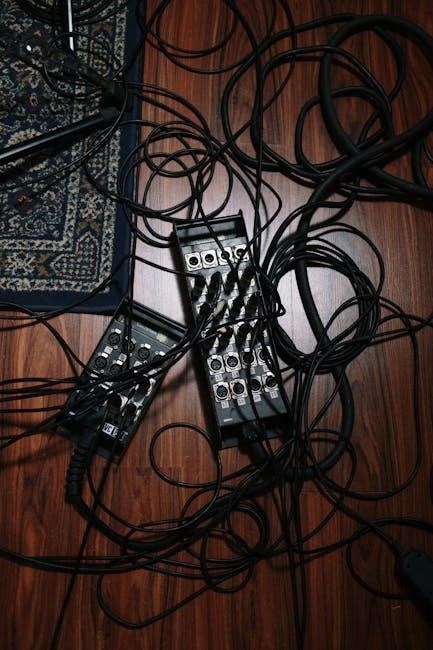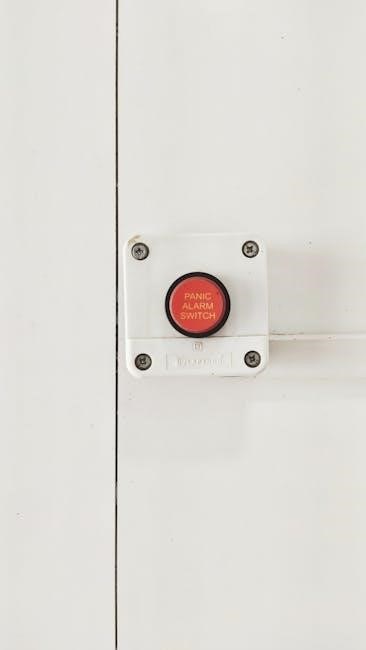
Welcome to the Reese Electric Brake Controller Manual‚ your comprehensive guide to installing‚ configuring‚ and operating this essential trailer braking system․ This manual ensures safe and efficient trailer braking by providing detailed instructions and troubleshooting tips for optimal performance․
Overview of the Reese Electric Brake Controller
The Reese Electric Brake Controller is a proportional braking system designed to enhance trailer braking performance․ It features a compact design‚ manual override functionality‚ and compatibility with various trailer types․ The controller ensures smooth‚ synchronized braking between the tow vehicle and trailer‚ improving safety on the road․ Its user-friendly interface and adaptable settings make it a reliable choice for towing enthusiasts․ This overview highlights its key functionalities and benefits‚ providing a foundation for understanding its operation and installation․
Importance of Proper Installation and Setup
Proper installation and setup of the Reese Electric Brake Controller are crucial for ensuring safe and reliable trailer braking performance․ Incorrect wiring or mounting can lead to unsafe braking conditions‚ potentially causing accidents․ Following the manual’s guidelines ensures optimal functionality‚ preventing hazards and guaranteeing smooth operation․ Proper setup also enhances the controller’s longevity and effectiveness‚ making it essential to adhere to the provided instructions carefully․ This step is vital for both safety and performance‚ ensuring your towing experience remains secure and stress-free․

Key Features and Benefits of the Reese Electric Brake Controller
The Reese Electric Brake Controller offers proportional braking for smooth stops‚ a manual override for emergencies‚ and a compact design for easy installation․ It ensures compatibility with various trailer types‚ enhancing safety and control during towing․
Proportional Braking for Smooth Trailer Stops
The Reese Electric Brake Controller features proportional braking‚ ensuring smooth and balanced trailer stops․ This advanced system synchronizes the trailer brakes with the vehicle’s deceleration‚ reducing wear and tear on both the trailer and vehicle․ By adjusting to the vehicle’s speed and braking intensity‚ it provides consistent control‚ enhancing safety and stability during towing․ This feature is particularly beneficial for drivers who tow varying trailer weights or drive in diverse road conditions․
Manual Override for Emergency Brake Control
The Reese Electric Brake Controller includes a manual override feature‚ allowing direct control of the trailer brakes in emergency situations․ Located on the front of the control unit‚ this feature enables independent activation of the trailer brakes without engaging the vehicle’s braking system․ This function is crucial for maintaining control and stability‚ especially when the trailer begins to sway or during sudden stops․ It provides an additional layer of safety‚ ensuring quick response when needed․
Compact Design for Easy Installation
The Reese Electric Brake Controller features a compact design‚ making it easy to install in various vehicle setups․ Its sleek dimensions allow for flexible mounting options without requiring extensive modifications․ The unit can be securely fastened in a convenient location‚ ensuring accessibility while maintaining a clean appearance․ This compact design simplifies the installation process‚ reducing the time and effort needed to integrate the brake controller into your vehicle’s electrical system․ It also minimizes space constraints‚ making it ideal for vehicles of all sizes․

System Components and Accessories
The Reese Electric Brake Controller includes a brake control unit‚ wiring harness‚ adapters‚ and mounting hardware‚ along with accessories for customized installation and optimal performance․
Brake Control Unit and Manual Knob
The Brake Control Unit is the core of the Reese Electric Brake Controller‚ regulating trailer brake activation․ The Manual Knob‚ located on the unit’s front‚ allows manual override for emergency braking․ Together‚ they ensure precise control over trailer braking systems․ Proper installation is crucial‚ with the unit mounted in an accessible location‚ avoiding vehicle floor drilling․ Clean the area of dirt and rust-proofing for secure mounting‚ ensuring reliable performance and safety during towing operations․
Wiring Harness and Adapters
The wiring harness and adapters are crucial for connecting the Reese Electric Brake Controller to your vehicle’s electrical system․ The harness includes pre-wired connectors for seamless integration‚ while adapters ensure compatibility with various vehicle setups․ Properly route the power input harness through a vacant grommet hole into the cabin‚ avoiding battery connection at this stage․ Follow the manufacturer’s wiring diagram‚ as colors may vary‚ to ensure accurate connections and reliable trailer brake operation․
Mounting Hardware and Accessories
The Reese Electric Brake Controller comes with mounting hardware and accessories to ensure secure installation․ The kit includes brackets‚ screws‚ and clips designed for durability and ease of use; These components are rust-resistant and built to withstand harsh environments․ Mounting hardware allows for flexible placement of the control unit‚ ensuring accessibility and safety․ Accessories like adhesive-backed clips help organize wiring‚ keeping your setup neat and professional․ Proper use of these items ensures a reliable and long-lasting brake control system․
Installation and Setup Guide
Prepare your vehicle and trailer for installation by cleaning the mounting area and routing wires properly․ Follow the manufacturer’s instructions to ensure safe and correct setup․
Preparing the Vehicle and Trailer for Installation
Before installing the Reese Electric Brake Controller‚ ensure your vehicle and trailer are properly prepared․ Clean the mounting area of dirt and rustproofing to ensure a secure fit․ Locate a suitable mounting spot for the brake control unit‚ avoiding areas like the vehicle floor or bed․ Inspect the wiring harness and adapters for any damage․ Ensure the trailer brakes are in good working condition and compatible with the controller․ Proper preparation ensures a safe and efficient installation process․
Wiring the Brake Controller to the Vehicle
Wiring the Reese Electric Brake Controller to your vehicle requires careful attention to detail․ Start by plugging the brake control adapter into the vehicle’s designated electric brake control port․ Route the power input harness through a vacant grommet hole into the cabin․ Avoid connecting the harness to the battery at this stage․ Ensure all wire connections are secure and match the manufacturer’s wiring diagram․ Refer to the controller’s instructions for specific wiring requirements and color codes to ensure proper functionality and safety․
Mounting the Brake Control Unit and Manual Knob
Select a suitable mounting location for the Brake Control Unit and Manual Knob‚ ensuring easy access and visibility․ Clean the area of dirt and rust-proofing before installation․ Avoid drilling into the vehicle floor or bed․ Mount the unit securely‚ following the manufacturer’s instructions․ Ensure the Manual Knob is positioned for convenient operation․ Proper mounting ensures reliable performance and safe operation of your Reese Electric Brake Controller․

Configuring the Brake Controller
Configure the brake controller by setting up the control unit and adjusting sensitivity․ Ensure proper electrical connections‚ calibrate for optimal braking performance‚ and follow manufacturer instructions․
Setting Up the Brake Control Unit
Setting up the brake control unit involves selecting a suitable mounting location‚ ensuring proper wiring connections‚ and calibrating the unit․ Mount the control unit in an accessible area‚ away from moisture and heat sources․ Connect the wiring harness to the vehicle’s electrical system‚ following the manufacturer’s instructions․ Calibrate the unit by adjusting the sensitivity settings to achieve smooth and responsive trailer braking․ Ensure the unit is level and securely fastened for accurate operation․
Adjusting the Braking Sensitivity
Adjusting the braking sensitivity ensures your trailer brakes respond appropriately to your vehicle’s deceleration․ Access the sensitivity setting on the brake control unit and adjust it to achieve smooth‚ proportional braking․ Use the manual override feature to test the trailer brakes and fine-tune the sensitivity for optimal performance․ Proper calibration ensures safe and controlled stopping‚ preventing over-braking or under-braking scenarios․ Always refer to the manual for specific adjustment instructions tailored to your Reese Electric Brake Controller model․

Operating the Reese Electric Brake Controller
Operating the Reese Electric Brake Controller involves using the manual override for emergency braking and adjusting sensitivity for smooth stops․ Ensure proper setup for safe towing experiences․
Using the Manual Override Feature

The manual override feature on the Reese Electric Brake Controller allows for direct control of the trailer brakes in emergency situations․ Located on the front of the control unit‚ this feature enables immediate braking action without relying on the vehicle’s braking system․ Simply activate the manual knob to apply the trailer brakes independently․ This feature is crucial for maintaining control and safety while towing․ Always ensure the manual override is easily accessible and adjust its sensitivity according to your towing needs for optimal performance․

Monitoring Brake Performance
Monitoring brake performance is crucial for ensuring safe and reliable trailer braking․ Regularly check the manual override function to confirm it engages the trailer brakes effectively․ Verify that all wiring connections are secure and free from corrosion․ Test the brakes during stops to ensure smooth and consistent performance․ Adjust the sensitivity settings as needed to maintain optimal braking control․ Proper monitoring helps prevent issues and ensures your towing experience remains safe and hassle-free․
Safety Precautions and Best Practices
Always inspect wiring connections for damage or corrosion‚ ensure proper grounding‚ and avoid exposing the controller to extreme temperatures to maintain safe and reliable braking performance․
Essential Safety Tips for Trailer Braking
Ensure proper wiring connections to avoid electrical faults․ Regularly inspect the brake control unit and wiring harness for damage or corrosion․ Always test the brakes before towing․ Mount the control unit securely to prevent vibration damage․ Use the manual override feature only in emergencies․ Keep the trailer brakes adjusted correctly to maintain even braking performance․ Avoid exposing the controller to extreme temperatures or moisture․ Follow all manufacturer guidelines for installation and maintenance to ensure safe and reliable operation․
Avoiding Common Installation Mistakes
Ensure the brake control unit is mounted securely to prevent vibration damage․ Avoid drilling into the vehicle floor or bed during installation․ Clean dirt and rustproofing from the mounting area for a secure fit․ Do not connect the harness to the battery until all wiring is complete․ Route the power input harness through a vacant grommet hole to protect it from damage․ Follow the manufacturer’s wiring diagram to avoid incorrect connections․ Properly ground the unit to prevent electrical interference and ensure reliable operation․
Troubleshooting Common Issues
Identify issues by checking wiring connections and ensuring proper power supply․ Verify brake performance and adjust settings as needed․ Consult the manual for detailed diagnostic steps․
Diagnosing Brake Controller Problems
Start by inspecting the wiring harness and connections for damage or corrosion․ Ensure the power supply to the brake control unit is stable and properly connected․ Check the trailer brakes for proper engagement and adjust sensitivity settings if necessary․ Refer to the manual for specific diagnostic procedures tailored to the Reese Electric Brake Controller․ Addressing issues promptly ensures reliable braking performance and safety on the road․
Resolving Wiring and Connection Issues
Begin by inspecting the wiring harness for damage or corrosion․ Clean connections thoroughly and ensure all plugs are securely attached․ Verify the brake control unit is properly connected to the vehicle’s electrical system․ If issues persist‚ consult the wiring diagram in the manual․ Use the correct adapters to maintain compatibility․ Avoid drilling into the vehicle floor or bed during installation․ Properly routing and securing wires prevents future problems‚ ensuring reliable brake control performance and safety on the road․

Maintenance and Upkeep
Regularly inspect and clean the wiring and connections to ensure optimal performance․ Check for wear and tear on components and replace them as needed․ Refer to the manual for specific maintenance schedules and guidelines to keep your Reese Electric Brake Controller functioning reliably․
Regular Maintenance for Optimal Performance
Regular maintenance is crucial for ensuring your Reese Electric Brake Controller operates efficiently․ Inspect the wiring and connections for corrosion or damage‚ and clean them as needed․ Check the brake control unit for dust or debris and ensure all components are securely mounted․ Refer to the manual for specific maintenance schedules and guidelines to keep your system functioning reliably and safely․ Regular upkeep prevents issues and ensures consistent braking performance․
Updating or Replacing Components
Regularly updating or replacing components of your Reese Electric Brake Controller ensures optimal performance and safety․ Check for software updates to enhance functionality and address any compatibility issues․ Replace worn-out or damaged parts‚ such as wiring harnesses or the manual control knob‚ to maintain reliable operation․ Always consult the manual for specific instructions and compatibility guidelines before making any changes․ Proper updates and replacements guarantee your brake controller remains efficient and effective over time․

Technical Specifications
The Reese Electric Brake Controller is compatible with up to 4 axles and supports both disc and drum brakes․ It operates on 12V DC power with a maximum current rating of 20 amps‚ ensuring reliable performance for various trailer types․
Compatibility with Various Trailer Types
The Reese Electric Brake Controller is designed to work seamlessly with a wide range of trailers‚ including boat‚ utility‚ and RV trailers․ Its versatility ensures compatibility with both disc and drum brake systems‚ making it suitable for trailers of different weights and configurations․ Whether you’re towing a small utility trailer or a large RV‚ this controller adapts to your needs‚ providing consistent and reliable braking performance across various setups․
Electrical Requirements and Ratings
The Reese Electric Brake Controller operates on a 12V DC power supply‚ ensuring compatibility with most vehicles․ It features a maximum amperage rating of 15 amps per channel‚ supporting up to 4 brake circuits․ Proper wiring is essential‚ with the controller requiring a direct connection to the vehicle’s battery and brake system․ Always follow the manufacturer’s guidelines for electrical connections to ensure safe and reliable operation․ Avoid connecting the harness to the battery during initial setup to prevent electrical surges․

The Reese Electric Brake Controller Manual provides essential guidance for safe and efficient trailer braking․ Proper installation and setup ensure optimal performance‚ enhancing towing safety and control․
Final Thoughts on the Reese Electric Brake Controller
The Reese Electric Brake Controller is a reliable and efficient solution for trailer braking systems․ Its proportional braking and manual override features ensure smooth and safe stops․ Designed for compatibility with various trailers‚ it offers durability and ease of use․ With proper installation and maintenance‚ this controller enhances towing safety and control‚ making it a valuable addition for any towing setup․
Resources for Further Assistance
For additional support‚ visit the official Reese website for detailed manuals‚ FAQs‚ and customer support contact information․ YouTube tutorials and forums like RV enthusiasts’ communities offer practical insights and troubleshooting tips․ Local auto parts stores may also provide hands-on assistance․ Ensure to consult certified professionals for complex issues‚ and refer to the downloadable PDF guides available online for comprehensive troubleshooting and maintenance instructions․